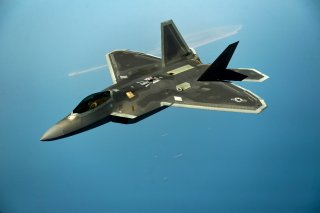Golden Horde: The Air Force Is Building the World’s Smartest Bombs
With Golden Horde, weapons themselves will be able to detect incoming threats and share updated targeting specifics with others.
What if two or more precision-guided bombs or missiles were able to share information in flight to adjust to changing targets, re-direct as needed, and thwart enemy attempts to jam their electronic guidance systems.
Such a concept is no longer a fantasy for the future—it is here. Last year, two Air Force F-16 fighter jets fired Small Diameter Bombs that used collaborative weapons coordination to share threat data with one another while in flight, allowing the bombs to change course in response to enemy guidance jamming signals. Developing weapons that gather, analyze, and share target specifics while in the air will introduce paradigm-changing capabilities.
Rapid progress with this emerging program, codenamed Golden Horde by the Air Force, is coming to fruition in part due to the Air Force Research Lab’s research and innovation efforts. In an interview with the National Interest, Maj. Gen. Heather Pringle of the Air Force Research Lab explained some of the technology driving this program.
“I've been really proud of the Golden Horde team and how they have really had a sense of urgency to deliver technologies and to look at networked, collaborative, autonomous architectures,” Pringle told the National Interest.
Golden Horde technology draws on software-defined radio signals to exchange data in-flight using computer processors preloaded with advanced algorithms. Following last years’ test, Pringle both praised the technical progress and emphasized that much work still needs to be done to advance the program.
Many pressing questions have yet to be answered about networking. For example, what types of radio technologies will work best for different target distances? Additionally, there are still questions about how to develop algorithms that work together more effectively, Pringle said last year following the test.
The tactical implications of the Golden Horde program are extremely significant, as air-launched weapons are quite likely to encounter weather obscurants, moving targets, and various enemy jamming attacks. With Golden Horde, weapons themselves will be able to detect the movement of incoming threats, process the new information, and share updated targeting specifics with another weapon also in flight. This, of course, greatly maximizes the lethality of air-attack weapons, allowing multiple weapons to be precisely redirected to a single target.
Kris Osborn is the defense editor for the National Interest. Osborn previously served at the Pentagon as a Highly Qualified Expert with the Office of the Assistant Secretary of the Army—Acquisition, Logistics & Technology. Osborn has also worked as an anchor and on-air military specialist at national TV networks. He has appeared as a guest military expert on Fox News, MSNBC, The Military Channel, and The History Channel. He also has a Masters Degree in Comparative Literature from Columbia University.
Image: Flickr/U.S. Air Force.

